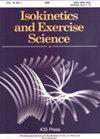Effect of different pelvic-drop exercises on hip muscles activity in patients with gluteus medius weakness
IF 0.7
4区 医学
Q4 ENGINEERING, BIOMEDICAL
引用次数: 0
Abstract
BACKGROUND: Pelvic-drop exercise (PD) is unilateral weight-bearing exercise that is frequently performed in rehabilitation sessions because its easy application can trigger moderate-to-high gluteus medius (Gmed) activity. Hip rotation has been applied to effectively facilitate Gmed activity during exercise. OBJECTIVE: To determine the effects of PD with three different hip rotations on Gmed, tensor fasciae latae (TFL), gluteus maximus (Gmax) activity, and Gmed:TFL activity ratio in patients with Gmed weakness. METHODS: Eighteen subjects with Gmed weakness participated. Subjects performed three different forms of PD with neutral hip, hip internal rotation, and hip external rotation position. Surface electromyography was performed to quantify the activity of Gmed, TFL, and Gmax. RESULTS: PD with hip internal rotation showed significantly greater Gmed activity than with neutral hip and hip external rotation (P= 0.005 and P= 0.007, respectively). TFL also showed significantly greater activity during PD with hip interna rotation than neutral hip (P= 0.002). There were no significant differences in Gmax activity (P= 0.095) and Gmed:TFL activity ratio (P= 0.254) among different forms of PD. CONCLUSIONS: PD with hip internal rotation is recommended to stimulate greater Gmed activity while preserving Gmed:TFL muscle activity ratio.不同骨盆下降运动对臀中肌无力患者髋部肌肉活动的影响
背景:骨盆下垂运动(PD)是一种单侧负重运动,在康复过程中经常进行,因为它的简单应用可以引发中高臀中肌(Gmed)活动。髋关节旋转已被应用于有效促进运动期间的Gmed活动。目的:确定三种不同髋关节旋转PD对Gmed无力患者的Gmed、阔筋膜张肌(TFL)、臀大肌(Gmax)活动和Gmed:TFL活动比率的影响。方法:18名Gmed弱的受试者参与。受试者进行了三种不同形式的PD,分别为中性髋关节、髋关节内旋和髋关节外旋体位。进行表面肌电图以量化Gmed、TFL和Gmax的活性。结果:髋关节内旋PD的Gmed活性明显高于中性髋关节和髋关节外旋PD(分别为P=0.005和P=0.007)。在髋关节内旋的PD过程中,TFL的活性也明显高于中性髋关节(P=0.002)。不同形式的PD的Gmax活性(P=0.095)和Gmed:TFL活性比(P=0.024)没有显著差异。结论:建议髋关节内旋转的PD在保持Gmed:TFL肌肉活性比的同时刺激更大的Gmed活性。
本文章由计算机程序翻译,如有差异,请以英文原文为准。
求助全文
约1分钟内获得全文
求助全文
来源期刊

Isokinetics and Exercise Science
医学-工程:生物医学
CiteScore
1.20
自引率
14.30%
发文量
37
审稿时长
>12 weeks
期刊介绍:
Isokinetics and Exercise Science (IES) is an international journal devoted to the study of theoretical and applied aspects of human muscle performance. Since isokinetic dynamometry constitutes the major tool in this area, the journal takes a particular interest in exploring the considerable potential of this technology.
IES publishes studies associated with the methodology of muscle performance especially with respect to the issues of reproducibility and validity of testing, description of normal and pathological mechanical parameters which are derivable from muscle testing, applications in basic research topics such as motor learning paradigms and electromyography. The journal also publishes studies on applications in clinical settings and technical aspects of the various measurement systems employed in human muscle performance research.
The journal welcomes submissions in the form of research papers, reviews, case studies and technical reports from professionals in the fields of sports medicine, orthopaedic and neurological rehabilitation and exercise physiology.
 求助内容:
求助内容: 应助结果提醒方式:
应助结果提醒方式:


